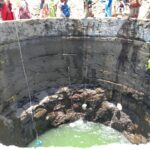Physical Address: Nashik, Maharashtra INDIA. For Business Call: 9326451122
Poultry info
Breeds & availability
- Types of Indian pure breeds
- Breeds of Poultry
- Jharsim: A location specific rural poultry variety for Jharkhand
- Kamrupa: A dual purpose variety for free range farming in Assam
- Pratapdhan: dual purpose coloured bird for Rajasthan
- Breeds from Central Avian Research Institute (CARI), Izatnagar
- Breeds from The Directorate of Poultry Research (ICAR), Hyderabad.
- Breeds from Karnataka Veterinary Animal Fishery Science and University, Bangalore
- Other native breeds
- Availability
- Related resources
Types of Indian pure breeds
There are only four pure Indian breeds of chicken available.
1. Aseel
- It is noted for its pugnacity, high stamina, majestic gait and dogged fighting qualities.
- The popular varieties of Aseel are, Peela (Golden red), Yakub (Black and red), Nuri (White), Kagar (Black), Chitta (Black and white spotted), Java (Black), Sabja (White and golden or black with yellow or silver), Teekar (brown) and Reza (light red).
- Pea comb, bright red wattle and ear lobes, long neck and strong legs
2. Chittagong
- It is also known as Malay.
- Dual-purpose bird.
- The popular varieties are buff, white, black, dark brown and grey.
- Pea comb, red ear lobes, over-hanging prominent eyebrows, feather-less shank
3. Kadaknath
- The skin, beak, shanks, toes and soles of feet are slate-like in colour
- Comb, wattles and tongue are purple.
- Most of the internal organs show intense black colouration and varying degrees of black colour are seen in the skeletal muscles, tendons, nerves, brain etc. The black pigment is due to the deposition of melanin.
4. Busra
- Medium sized bird, deep bodied, light feathered and alert in nature.
- Poor layer.
- Wide variation in body colour
Breeds of Poultry
Jharsim: A location specific rural poultry variety for Jharkhand
Jharsim is a dual purpose location specific poultry variety suitable for Jharkhand state. The variety is developed under All India Co-ordinated Research Project on Poultry Breeding, Birsa Agricultural University, Ranchi Centre.
The name Jharsim is derived from Jhar for Jarkhand and sim meaning hen in tribal dialect. These birds have attractive multi-colour plumage, perform better on low level of nutrition, faster growth, optimum egg production and better adaptability to agro climatic conditions of Jharkhand. The birds weigh 400-500g at 6 weeks and 1600-1800 g at maturity under backyard system. The age at first egg laying is 175-180 days and egg weight is 52-55g at 40 weeks of age. The birds have the potential to lay 165-170 eggs and under backyard system. This variety can provide higher supplementary income and nutrition through both egg and meat to rural/ tribal population of the state.
Kamrupa: A dual purpose variety for free range farming in Assam
“Kamrupa” is a multi-coloured bird for 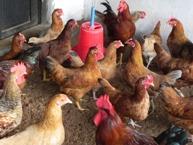 rural poultry production developed under All India Coordinated Research Project on Poultry Breeding at Assam Agriculture University, Khanapara, Guwahati, Assam. It is three way cross developed using Assam local ecotype (25%), Coloured Broiler (25%) and Dalhem Red (50%) population. This variety has coloured plumage, mediocre body weight and longer shanks with optimum egg production. Under backyard system, the body weight at 8 and 20 weeks is 500-650 grams and 1300-1500grams, respectively. The male birds weigh 1800-2200 grams at 40 weeks of age the annual egg production is 118-130 eggs with an egg weight of 52 grams.
rural poultry production developed under All India Coordinated Research Project on Poultry Breeding at Assam Agriculture University, Khanapara, Guwahati, Assam. It is three way cross developed using Assam local ecotype (25%), Coloured Broiler (25%) and Dalhem Red (50%) population. This variety has coloured plumage, mediocre body weight and longer shanks with optimum egg production. Under backyard system, the body weight at 8 and 20 weeks is 500-650 grams and 1300-1500grams, respectively. The male birds weigh 1800-2200 grams at 40 weeks of age the annual egg production is 118-130 eggs with an egg weight of 52 grams.
Pratapdhan: dual purpose coloured bird for Rajasthan
Pratapdhan is a dual purpose chicken variety to cater to the needs of rural poultry keepers of Rajasthan. 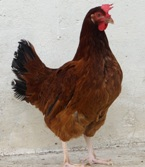 It was developed as part of AICRP on Poultry Breeding by MPUAT, Udaipur. It resembles local birds of Rajasthan. Attractive multicolour feather pattern, as rural people like coloured birds from aesthetic point of view and better looking. Because of colour plumage birds have camouflagic characters to protect themselves from predators. Birds have longer shank length which helps in self protection from predators in backyard areas and has capacity to survive on low plane of nutrition (low and negligible input) and harsh climatic conditions. It lays brown eggs weighing around 50 g and has broody characteristic to some extent. It has fast growth rate with average adult body weight at 20 weeks of age ranged from 1478 to 3020 g in males and 1283 to 2736 g in females. The age at sexual maturity was 170 days. Pratapdhan produces 161 eggs annually, which is 274% higher than local native (43 eggs). For the complete information, click here.
It was developed as part of AICRP on Poultry Breeding by MPUAT, Udaipur. It resembles local birds of Rajasthan. Attractive multicolour feather pattern, as rural people like coloured birds from aesthetic point of view and better looking. Because of colour plumage birds have camouflagic characters to protect themselves from predators. Birds have longer shank length which helps in self protection from predators in backyard areas and has capacity to survive on low plane of nutrition (low and negligible input) and harsh climatic conditions. It lays brown eggs weighing around 50 g and has broody characteristic to some extent. It has fast growth rate with average adult body weight at 20 weeks of age ranged from 1478 to 3020 g in males and 1283 to 2736 g in females. The age at sexual maturity was 170 days. Pratapdhan produces 161 eggs annually, which is 274% higher than local native (43 eggs). For the complete information, click here.
Breeds from Central Avian Research Institute (CARI), Izatnagar
Desi Types / Backyard Types
CARI NIRBHEEK (Aseel Cross)
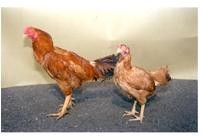
- The literal meaning of Aseel is real or pure. Aseel is well known for its pugnacity, high stamina, majestic gait and dogged fighting qualities. The name Aseel appears to have been given to this indigenous breed because of its inherent qualities of fighting.
- Andhra Pradesh is said to be the home of this important breed. The best specimen of this breed, although rare, are encountered with the fanciers and the people engaged in cock-fighting show through out the country.
- Aseel is larger in built with noble looking and dignified appearance.
- The standard weight varies from 3 to 4 kg for cocks and 2 to 3 kg for hens.
- Age at sexual maturity (days) 196 days
- Annual egg production (number) 92
- Egg weight at 40 week (g) 50.
CARI SHYAMA (Kadakanath Cross)
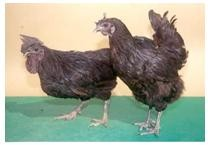
- It is locally known as “Kalamasi” meaning the fowl having black flesh. Jhabua and Dhar districts of Madhya Pradesh and the adjoining districts of Rajasthan and Gujarat spreading over an area of about 800sq. miles is considered to be its home tract.
- These are mostly reared by tribals, adivasis and rural poor. It is considered to be a sacred bird and offered as sacrifice to Goddess after Diwali.
- The colour of the day old chicks is bluish to black with irregular dark stripes over the back.
- The flesh of this breed though black and repulsive to look at, is considered not only a delicacy but also of medicinal value.
- The tribal uses Kadakanath blood in the treatment of chronic disease in human beings and its meat as aphrodisiac.
- The meat and eggs are reckoned to be a rich source of protein (25.47% in flesh) and iron.
- Body weight at 20 weeks (g) 920
- Age at sexual maturity (days) 180
- Annual egg production (number) 105
- Egg weight at 40 week (g) 49
- Fertility (%) 55
- Hatchability FES (%) 52
HITCARI (Naked Neck Cross)
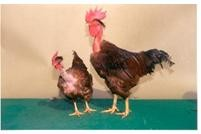
- Naked neck is relatively larger in built with long cylindrical neck. As the name indicates, neck of the birds is fully naked or only a tuft of feathers is seen on the front of the neck above crop.
- The resulting bare skin becomes reddish particularly in males as they approach sexual maturity.
- Trivandrum region of Kerala is considered to be the homeland of Naked neck
- Body weight at 20 weeks (g) 1005
- Age at sexual maturity (days) 201
- Annual egg production (number) 99
- Egg weight at 40 week (g) 54
- Fertility (%) 66
- Hatchability FES (%) 71
UPCARI (Frizzle Cross)
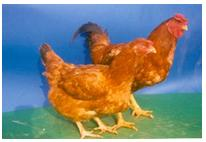
Unique scavenging type birds developed with native breed base, having typical desi fowl look, better tropical adaptability and disease resistance, exceptional growth and production performance. Best suited for backyard system of poultry production.
Four varieties of UPCARI birds suitable for different agro-climatic conditions are available.
- Kadakanath x Dehlam Red
- Aseel x Dehlam Red
- Naked Neck x Dehlam Red
- Frizzle x Dehlam Red
Performance Profile
- Age at sexual maturity 170-180 days
- Annual egg production 165-180 eggs
Egg size 52-55 g - Egg colour Brown
- Egg quality Excellent Internal quality
- Livability Above 95%
- Temperament Active and good forager
Layers
CARI PRIYA LAYER
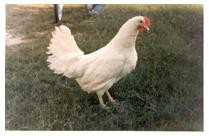
- First egg at 17 to 18 weeks
- 50% production at 150 days
- Peak production at 26 to 28 weeks
- Liveability of grower (96%) and layer (94%)
- Egg production peak 92%
- Hen Housed to 72 wk. more than 270 eggs
- Egg size Average
- Egg weight 54 g
Cari Sonali Layer(Golden – 92)
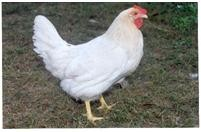
- First egg at 18 to 19 weeks
- 50% production at 155 days
- Peak production at 27 to 29 weeks
- Livability of grower (96%) and layer (94%)
- Egg production Peak 90%
- Hen Housed to 72 wk. more than 265 eggs
- Egg size Average
- Egg weight 54 g
CARI-DEVENDRA
- A medium -sized dual- purpose bird
- Efficient feed conversion – High positive return over feed cost
- Superiority over other stocks- Low laying house mortality
- Body weight at 8th week-1700-1800g
- Age at sexual maturity-155-160 days
- Annual egg production- 190-200
Broilers
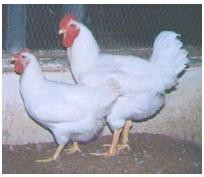
CARIBRO-VISHAL (CARIBRO-91)
- Weight at day old : 43g
- Weight at 6 weeks : 1650 to 1700g
- Weight at 7 weeks : 2100 to 2200g
- Dressing percentage : 75%
- Livability percentage : 97-98%
- Feed conversion ratio at 6 weeks : 1.94 to 2.20
CARI-RAINBRO (B-77)
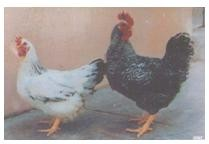
- Weight at day old : 41g
- Weight at 6 weeks : 1300 g
- Weight at 7 weeks : 1600 g
- Dressing percentage : 73%
- Livability percentage : 98-99%
- Feed conversion ratio at 6 weeks : 2.3
CARIBRO-DHANRAJA (Multi-Coloured)
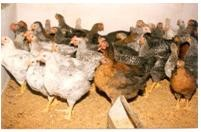
- Weight at day old : 46g
- Weight at 6 weeks : 1600 to 1650g
- Weight at 7 weeks : 2000 to 2150g
- Dressing percentage : 73%
- Livability percentage : 97-98%
- Feed conversion ratio at 6 weeks : 1.90 to 2.10
CARIBRO-MRITUNJAI (CARI Naked Neck)
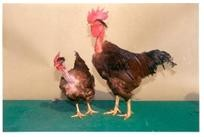
- Weight at day old : 42g
- Weight at 6 weeks : 1650 to 1700g
- Weight at 7 weeks : 2000 to 2150g
- Dressing percentage : 77%
- Livability percentage : 97-98%
- Feed conversion ratio at 6 weeks : 1.9 to 2.0
Quails
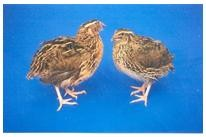
- Japanese quail have created a big impact in recent years and many quails farms have been established through out the country both for egg and meat production. It is due to fact that increasing consumer awareness for quality meat.
- The following factors, which made quail farming as economically viable and technically feasible.
- Very short generation interval
- Quails are very robust to diseases
- No vaccination is required
- Low space requirement
- Easy to handle
- Early maturity
- Very high laying intensity- female starts laying at an age of 42
CARI UTTAM
- Hatchability on total eggs set: 60-76%
- Weight at 4 weeks: 150 g
- Weight at 5 weeks: 170-190 g
- Feed efficiency at 4 weeks: 2.51
- Feed efficiency at 5 weeks: 2.80
- Daily feed consumption: 25-28 g
CARI UJJAWAL
- Hatchability on total eggs set 65%
- Weight at 4 weeks 140 g
- Weight at 5 weeks 170-175 g
- Feed efficiency at 5 weeks 2.93
- Daily feed consumption: 25-28 g
CARI SWETA
- Hatchability on total eggs set 50-60%
- Weight at 4 weeks 135 g
- Weight at 5 weeks 155-165 g
- Feed efficiency at 4 weeks 2.85
- Feed efficiency at 5 weeks 2.90
- Daily feed consumption: 25 g
CARI PEARL
- Hatchability on total eggs set: 65-70%
- Weight at 4 weeks: 120 g
- Daily feed consumption: 25 g
- Age at 50% egg production: 8-10 wk
- Hen day production: 285-295 eggs
Guinea fowl
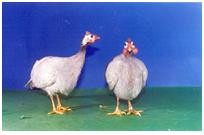
- Guinea fowl are highly free moving birds.
- Best suited for marginal and small farmers
- Three available varieties are KADMBARI, CHITAMBARI and SWETAMBARI
Special features
- Hardy bird
- Suitable to any agro-climatic condition
- Resistant to many common diseases of chicken
- No requirement of elaborate and expensive housing
- Excellent foraging capabilities
- Consumes all non-conventional feed not used in chicken feeding
- More tolerant to mycotoxin and aflatoxin
- Hard egg shell provides minimum breakage and long keeping quality
- Guinea fowl meat is rich in vitamin and low in cholesterol
Production characteristics
- Weight at 8 weeks 500-550 g
- Weight at 12 weeks 900-1000 g
- Age at first egg 230-250 day
- Average egg weight 38-40 g
- Egg production (in one laying cycle from March to September) 100-120 eggs
- Fertility 70-75%
- Hatchability on fertile eggs set 70-80%
Turkey
CARI-VIRAT
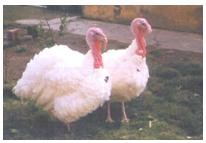
- Broad Breasted White type
- Turkey is marketed as broiler at approximately 16 weeks of age when hens usually reach a live weight of about 8 kg and toms weigh approximately 12 kg.
- Smaller, fryer roasters can be produced by slaughtering at an earlier age as per the demand of the local market.
For availability of breeds please contact:
Director
Central Avian research Institute
Izatnagar, UP
Pin: 243 122
E-mail: cari_director@rediffmail.com
Ph: 91-581-2301220; 2301320; 2303223; 2300204
Fax: 91-581-2301321
Breeds from The Directorate of Poultry Research (ICAR), Hyderabad.
Gramapriya
It is a layer type variety and was developed for free range farming in rural and tribal areas. 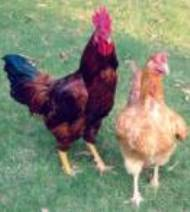 The bird has the production potential of 230-240 eggs in a year and can lay 160-180 eggs in free-range conditions with minimum supplementary feeding. The males weigh around 1.2 to 1.5kg at 15 wks of age and suitable for tandoori preparations. The bird has coloured plumage and lays bigger (57-59g) and brown eggs. It is hardy and livability is high. The rural and tribal farmers of many states are being profited by this variety.
The bird has the production potential of 230-240 eggs in a year and can lay 160-180 eggs in free-range conditions with minimum supplementary feeding. The males weigh around 1.2 to 1.5kg at 15 wks of age and suitable for tandoori preparations. The bird has coloured plumage and lays bigger (57-59g) and brown eggs. It is hardy and livability is high. The rural and tribal farmers of many states are being profited by this variety.
For the complete information, click here.
Sinidhi
Srinidhi is a dual purpose variety for rural poultry production. Srinidhi has optimum body weight and better egg production. It was evaluated twice for full length of production cycle of 72 weeks at the Directorate of Poultry Research farm. Its juvenile body weight at 6 weeks of age was 650 g and males weighed 2353 g at 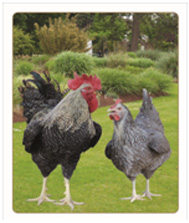 15 weeks of age. The age at sexual maturity was 161 days. The egg production upto 40 weeks of age was 90 eggs and the annual egg production was 228 eggs under intensive system of rearing. The survivability was more than 95%.
15 weeks of age. The age at sexual maturity was 161 days. The egg production upto 40 weeks of age was 90 eggs and the annual egg production was 228 eggs under intensive system of rearing. The survivability was more than 95%.
Subsequently, the variety was evaluated under field conditions in Tripura, Jharkhand and Andhra Pradesh. In the backyards, the juvenile body weight at 6 weeks of age was 500-550 g, the age at sexual maturity was 170-175 days. The egg production upto 40 weeks of age was 55-60 eggs and the bird has potential to lay 140-150 eggs per year under backyard.
Salient features under rural backyards
- Multi coloured plumage
- Longer shanks
- Coloured and bigger eggs (53-55 g)
- Juvenile b.wt. : 500-550 g at 6 weeks
- Early maturing (175 days)
- Annual egg production : 150 eggs
For the complete information, click here.
VANARAJA
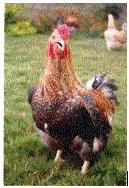
- Suitable bird for backyard farming in rural and tribal areas, developed by the Project Directorate on Poultry (ICAR), Hyderabad.
- It is a multi-coloured dual purpose bird with attractive plumage.
- It has better immune status against common poultry diseases and is adaptable to the free range rearing.
- Vanaraja males attain moderate body weight at 8 weeks of age under regular feeding system
- The hen lays 160-180 eggs in a laying cycle
- Due to their relatively light weight and long shanks, these birds are capable to protect themselves from predators which are otherwise a major problem observed in birds reared in backyards.
For the complete information, click here.
KRISHIBRO
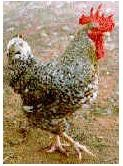
- Developed by the Project Directorate on Poultry (ICAR), Hyderabad.
- Multi-colored commercial broiler chicks
- Attain body weight by 6 weeks of age with less than 2.2 feed conversion ratios.
- The survivability of this bird up to 6 weeks of age is around 97%.
- These birds have attractive color plumage and are well adapted to tropical weather conditions.
- The commercial Krishibro has highly resistance against the common poultry diseases like Ranikhet and Infectious bursal disease.
- Advantages : Hardy, Well adapted and Better survivability
For the complete information, click here.
For availability of breeds please contact:
Directorate of Poultry Research, Rajendranagar, Hyderabad 500 030, Telangana, India
Ph : +91-40-24015651, 24017000 (Monday to Saturday except 2nd Saturdays of each month and National Holidays)
Germplasm supply & Hatchery : +91-40-24018687
Breeds from Karnataka Veterinary Animal Fishery Science and University, Bangalore
Swarnadhara
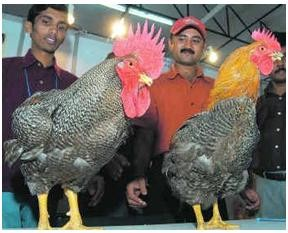
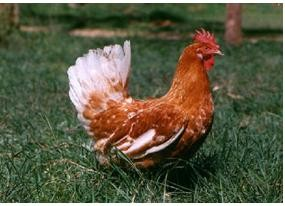
Developed by Department of Poultry Science, University of Agricultural Sciences, Bangalore, presently Karnataka Veterinary Animal Fishery Sciences University, Hebbal, Bangalore
- This breed yields 15-20 eggs in a year more than Giriraja chicken breed and was released by the Karnataka Veterinary Animal Fishery Sciences University, Bangalore in 2005. Swarnadhara chickens have a high egg production potential along with better growth compared to other local varieties and are suited for mixed and backyard farming
- Compared to Giriraja breed, Swarnadhara breed are smaller in size with a lighter body weight, which makes them easier to escape attacks from predators such as jungle cats and foxes
- The bird can be reared for its eggs and meat.
- It attains maturity from the 22-23rd week after hatching.
- Hens attain a body weight of about 3 kg and the cocks about 4 kg.
- Swarnadhara hens lay about 180-190 eggs in a year.
For availability of breeds please contact:
Prof and Head,
Department of Avian Production and Management,
Karnataka Veterinary Animal Fishery Sciences University,
Hebbal, Bangalore: 560024,
Phone: (080) 23414384 or 23411483 (ext)201.
Other native breeds
| Breed | Home Tract |
| Ankaleshwar | Gujarat |
| Aseel | Chhattisgarh, Orissa and Andhra Pradesh |
| Busra | Gujarat and Maharashtra |
| Chittagong | Meghalaya and Tripura |
| Danki | Andhra Pradesh |
| Daothigir | Assam |
| Ghagus | Andhra Pradesh and Karnataka |
| Harringhata Black | West Bengal |
| Kadaknath | Madhya Pradesh |
| Kalasthi | Andhra Pradesh |
| Kashmir Faverolla | Jammu and Kashmir |
| Miri | Assam |
| Nicobari | Andaman & Nicobar |
| Punjab Brown | Punjab and Haryana |
| Tellichery | Kerala |
| Mewari | Rajasthan |
Availability
Desi types or backyard types of poultry birds are being supplied by the following organisations
- Breeds from Central Aviation Research Institute (CARI)
- Directorate of Poultry Research (ICAR), Hyderabad
- Karnataka Veterinary, Animal and Fisheries Sciences University, Bidar, Karnataka
- Kadaknath KB Livestock Farm
Source: Expert System on Poultry, ICAR-TANUVAS-TNAU
Narmada Nidhi – A hybrid variety of chicken
‘Narmada Nidhi’ is a improved location specific variety of chicken developed by the College of Veterinary Science and Animal Husbandry, Nanaji Deshmukh Pashu Chikitsa Vigyan Vishwa Vidyalaya (Nanaji Deshmukh Veterinary Science University), Jabalpur, Madhya Pradesh. The dual purpose coloured bird is suitable for rural and tribal areas poultry farming in Madhya Pradesh.
Breed development
- It has been developed by crossing Kadaknath (Native chicken breed) with Jabalpur colour (Coloured broiler).
- Parental lines – Kadaknath is a local breed of chicken found in tribal dominated Jhabua and Alirajur districts of MP. The ‘Jabalpur colour’ breed chicken is an improved breed of chicken developed by the Jabalpur university
- The breed has been developed in such a way that terminal cross has 25% inheritance of Kadaknath breed and 75% inheritance of Jabalpur colour variety.
Features of the breed
- It is a dual purpose dual purpose coloured chicken Variety. They have very attractive multi-colour plumage pattern (black, brown, grey and mixed) and strong body conformation and move fast in free range. These features help in scavenging and also to protect these birds from predators.
- It has been exclusively developed for backyard, free range scavenging and semi intensive systems of rearing.
- Narmadanidhi birds thrive well and adapt to harsh climatic conditions and are preferred by farmers even in remote areas.
- The breed resembles native chicken in appearance but has higher growth and production potential, survive better in sub-optimal nutrition and management.
- The birds attain 700 to 800g at 8 weeks of age under backyard/free-range. Body weight of male and female birds at 20 weeks of age is around 1550 and 1300g, respectively, under backyard conditions.
- The female matures on an average 161 days of age (intensive) and produces 181 eggs in backyard 4 times higher than the local native (45 eggs) and 195 under semi intensive system of management. The eggs are brown shelled eggs and of medium size (50.2g).
Quail Farming
- Introduction to quail farming
- Housing management of quails
- Feeding management of quails
- General management of quails
- Breeding management of quails
- Diseases of quails
- Challenges in quail rearing
- Licence requirement for quail farming
- Related Resources
Introduction to quail farming
Advantages of quail farming
- Requires minimum floor space
- Needs low investment
- Quails are comparatively sturdy birds
- Can be marketed at an early age ie. five weeks
- Early sexual maturity – starts laying eggs in about six to seven weeks of age
- High rate of egg laying -280 eggs per year
- Quail meat is tastier than chicken and has less fat content. It promotes body and brain development in children.
- Nutritionally, the quail eggs are on par with that of chicken eggs. Moreover, they contain less cholesterol.
- Quail meat and eggs are a nutritious diet for pregnant and nursing mothers.
- Raising quails is very easy, even the beginners can raise them.
- Commercial quail farming can be a good and profitable business idea for the ededated unemployed youths.
- Quails are smaller sized birds. So you will need relatively less capital for starting this business.
Housing management of quails
1. Deep litter system
- 6 quails can be reared in a sq.ft. of floor space.
- After 2 weeks, Quails can be reared in cages. This will help to gain good body weight, as unnecessary wandering of animals is avoided.
2. Cage System
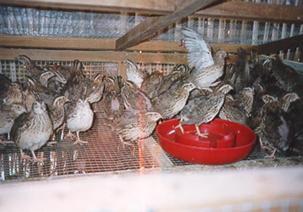
| Age | Cage Size | No.of birds |
| First 2 weeks | 3 x 2.5 x 1.5 ft. | 100 |
| 3- 6 weeks | 4 x 2 .5 x 1.5 ft. | 50 |
Quails in cage system of rearing
- Each unit is about 6 feet in length and 1 foot in width, and subdivided into 6 subunits.
- To save space, the cages can be arranged upto 6 tiers high. There can be 4 to 5 cages in a row.
- The bottom of the cage is fixed with removable wooden plates to clean the bird droppings.
- Long narrow feed troughs are placed in front of the cages. Water troughs are placed at the back of the cages.
- Commercial egg layers are usually housed in colonies of 10-12 birds per cage. For breeding purposes, male quails are introduced in the cages in the ratio of 1 to 3 females.
Feeding management of quails
Feed can be formulated as follows.
| Feed Ingredients | Chick mash | Grower mash |
| 0-3 weeks | 4-6 weeks | |
| Maize | 27 | 31 |
| Sorghum | 15 | 14 |
| Deoiled RiceBran | 8 | 8 |
| Groundnut Cake | 17 | 17 |
| Sunflower Cake | 12.5 | 12.5 |
| Soya meal | 8 | – |
| Fishmeal | 10 | 10 |
| Mineral Mixture | 2.5 | 2.5 |
| Shell grit | – | 5 |
- Feed material should be made of small particles
- A 5 weeks old quail consumes about 500 gms of feed
- Quails of 6 month old, consumes about 30-35 gms of feed per day.
- Quails require about 400 gms feed for the production of 12 eggs.
- Broiler starter mash can be used by adding 5 kg of oil cakes to 75 feed. The particle size is reduced by grinding the feed for one more time.
General management of quails
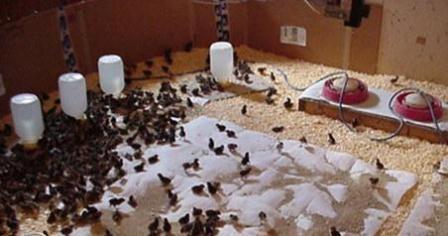
- At the age of six weeks, female quails usually weigh 175-200 g and the males weigh about 125-150 g
- Female quails start laying eggs at 7 weeks of age and continue utpo 22 weeks of age
- Usually egg laying happens during the evening time of the day
- The quail egg usually weighs about 9-10 g
- The breast of the male quail is usually narrow and covered with equally distributed brown and white feathers. But the female quail has a broad breast covered with brown feathers with black dots.
- The female and male quails should be separated at the age of four weeks
- Sixteen hours of light per day should be available to the egg laying quails
Management of quail chicks
The day old quail chicks usually weigh 8-10 g. Hence, the quail chicks need more temperature. Absence of adequate temperature and exposure to high speed cool wind leads to clustering of young ones, which results in high mortality.
Breeding management of quails
Quail eggs
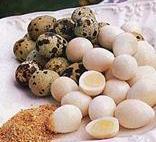
- Quails start laying their eggs at the age of 7th week. They attain 50% egg production at 8th week of age
- In order to produce fertile eggs, the male quails should be reared along with the females at 8-10 weeks of age
- The male, female ratio is 1:5
- Incubation period in quails is 18 days
- With 500 female quails we can produce 1500 quail chicks per week
Quail Meat
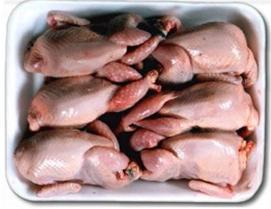
Diseases of quails
- When there is deficiency of vitamins and minerals in the female quail breeders, the chicks obtained from their fertile eggs are usually lean with weak legs. To prevent this the breeder females should be provided with optimum minerals and vitamins in their feed
- Generally quails are resistant to infectious diseases than chicken. So there is no vaccination required for quails
- Proper management of quail chicks, disinfecting farm premises, providing clean drinking water to quails and feeding of quality concentrate feed will prevent disease outbreaks in quail farms
Source: Handbook on Animal Husbandry, ICAR and Text books on poultry production
Challenges in quail rearing
- Male quails usually make a different sound which is usually disturbing to the human
- When rearing the male and female quails together, the male quails peck the other quails and make them blind. At times, death of the quails are also noticed.
Licence requirement for quail farming
Quail being a protected species, a government license is required to sell it commercially. In India, the Department of Animal Husbandry, Dairy and Fisheries is responsible to grant such license as delegated by the Ministry of Environment and Forests. Several quail licenses have been already issued (more than 500 in Maharashtra State only).
Here are the important terms and conditions for Quail license as per letter No.3-22/84 – FRY (WL) dated 27.06.1997 of Ministry of Environment and Forests, New Delhi:
- Validity of license up to one year from the date of issue & shall be charged Rs. 200/-, 500/-, 500/- & 1000/- each purpose respectively for farming, Trading, catering & Hatchery. It can be renewed before expiry of current license with requisite fees.
- The purchaser should purchase quails from a license holder.
- Issuing authority can inspect the facilities available at site any time during the period of license.
- Nonfunctional licenses are likely to be canceled before expiry, with prior intimation.
- Preconditions for quail farming and/or quail trading:
- The farm should be located at not less than 4.5 to 5.0 km. away from the notified forest area if there is no human inhabitation in between.
- The farm should be located at a distance not less than 2.5 to 3.0 km away from wildlife & forest area where there is human habitation between the farm & forest/ wildlife notified area.
- The farm should not be closed to water logged area.
- The farm should strictly observe bio-security measures particularly hygiene & sanitation within enclosures & provide basic health cover for the birds. Birds should not be allowed to roaming the open outside enclosures.
- There should be adequate fencing around the farm/ building to avoid entry of stray animals & for the public to come in direct contact with birds.
- License shall be issued subject to production of original documents for identity as follows: ration Card, Driving License, Election I-card or Valid Identity card.
Source: ICAR – Central Coastal Agricultural Research Institute
Turkey Farming
- Breeds of turkeys in India
- Economic Parameters in Turkey Farming
- General turkey management
- Turkey rearing systems
- Floor, feeder and waterer space requirement of turkeys
- Care to be taken while rearing Turkeys
- Feeding management of turkeys
- Breeding practices
- Common Diseases of Turkey and their prevention
- Turkey meat and egg
- Related Resources
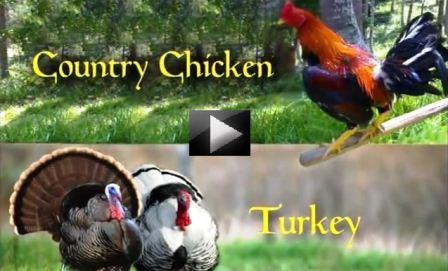
Breeds of turkeys in India
1. Broad breasted bronze
The basic plumage color is black and not bronze. The females have black breast feathers with white tips, which help in sex determination as early as 12 weeks of age.
2. Broad breasted white
This is a cross between Board breasted bronze and White Holland with white feathers. White plumage turkeys seems to be suitable Indian-Agro climatic conditions as they have better heat tolerance and also good and clean in appearance after dressing.
3. Beltsville small white
It closely resembles the Board breasted white in color and shape but smaller in size. Egg production, fertility and hatchability tend to be higher and broodiness tends to be lower than heavy varieties.
4. Nandanam Turkey-1
Nandanam Turkey – 1 variety is a cross between the black desi variety and exotic Beltsville small white variety. It is suited for Tamil Nadu climatic conditions.
Economic Parameters in Turkey Farming
| Male – Female ratio | 1:5 |
| Average egg weight | 65 gms |
| Average day old young one weight | 50 gms |
| Age at sexual maturity | 30 weeks |
| Average egg number | 80 -100 |
| Incubation Period | 28 days |
| Average body weight at 20 weeks | 4.5 – 5 (Female) 7-8 (Male) |
| Egg production period | 24 weeks |
| Marketable age Male Female | 14 -15 weeks 17 – 18 weeks |
| Marketable weight Male Female | 7.5 kg 5.5 kg |
| Food efficiency | 2.7 -2.8 |
| Average feed consumption upto marketable age Male Female | 24 -26 kg 17 – 19 kg |
| Mortality during brooding period | 3-4% |
General turkey management
I. Incubation:
The incubation period is 28 days in turkey. There are two methods of incubation.
(a) Natural incubation with broody hens:
Naturally turkeys are good brooders and the broody hen can hatch 10-15 numbers of eggs. Only clean eggs with good eggshell and shape should be placed for brooding to get 60-80% hatchability and healthy young ones.
(b) Artificial Incubation:
In artificial incubation, eggs are hatched with the help of incubators. The temperature and relative humidity in setter and hatcher are as follows:
| Temperature (Degree F) | Relative humidity (%) |
| Setter 99.5 | 61-63 |
| Hatcher 99.5 | 85-90 |
Egg should be turned at hourly intervals daily. Eggs should be collected frequently to prevent soiling and breakage and also to get better hatchability.
Brooding
In turkey 0-4 weeks period is called as brooding period. However, in winter brooding period is extended upto 5-6 weeks. As a thumb rule the turkey young ones need double hover space as compared to chicken. Brooding day old young ones can be done using infra red bulbs or gas brooder and traditional brooding systems.
Points to be noted during brooding:
- The floor space requirement for 0-4 weeks is 1.5 sq.ft. per bird.
- The brooder house should be made ready atleast two days before the arrival of young ones
- The litter material should be spread in a circular manner with a diameter of 2 mtrs.
- To prevent the young ones from wandering away from source of heat, a fence of atleast 1 feet height must be provided
- Starting temperature is 950F followed by weekly reduction of 50F per week upto 4 weeks of age
- Shallow waterers should be used.
The average mortality rate is 6-10% during the first four weeks of life. Young ones by nature are reluctant to eat and drink in the first few days of life, primarily because of bad eyesight and nervousness. Hence, they have to be force fed.
Force Feeding
Starve out problem is one of the major factors for early mortality in young ones. So special care should be taken for supplying feed and water to turkey poults. In force feeding, milk should be fed at the rate of 100ml per liter of water and one boiled egg have to be given at the rate of one per 10 young ones up to fifteen days. This will compensate the protein and energy requirements of the young ones.
Young ones can be attracted to the feed by gentle tapping of the container with the fingers. Colored marbles or pebbles placed in feeders and waterers will also attract young ones towards them. Since turkeys are fond of greens, some chopped green leaves should also be added to the feed to improve the feed intake. Also colored egg fillers can be used for the first 2 days as feeders.
Turkey rearing systems
Turkeys can be reared under free range or intensive system.
A. Free range system of rearing:
Advantages:
- It reduces the feed cost by fifty percent.
- Low investment.
- Cost benefit ratio is high.
In the free range system, in one acre of fenced land we can rear 200-250 adult turkeys. Shelter should be provided during night at the rate of 3-4 sq.ft. per bird. They should be protected from predators during scavenging. Planting of trees is desirable for providing shade and cooler environment. The range should be rotated which will help to reduce incidence of parasite infestation.
Free range feeding
Since turkeys are very good scavengers, it can consume earthworms, small insects, snails, kitchen waste and termites, which are rich in protein and that will reduce the feed cost by fifty percent. Apart from this leguminous fodder like Lucerne, Desmanthus, Stylo etc., can be fed. To avoid leg weakness and lameness in free ranging birds, calcium should be supplemented at the rate of 250gm per week per bird in the form of oyster shell. Ten percent of feed can be substituted with vegetable waste to reduce the cost of feed.
Health cover
Turkeys in the free range system are highly susceptible for internal (round worms) and external parasites (fowl mite). Hence once in a month deworming and dipping is essential to improve the growth of the birds.
B. Intensive system of rearing
Advantages
- Improved production efficiency.
- Better management and disease control.
Housing
- Housing protects turkeys form sun, rain, wind, predators and provides comfort.
- In hotter parts of the country the long axis of the house should run from East to West.
- The distance between two houses should be at least 20 meters and the young stock house should be at least 50 to 100 meters away from the adult house.
- The width of the open house should not exceed 9 meters.
- The height of the house may vary from 2.6 to 3.3 meters from the floor to roof.
- An overhang of one meter should be provided to avoid the rainwater splash.
- The floor of the houses should be cheap, durable and safe preferably concrete with moisture proof.
When turkeys are reared under deep litter system, the general managemental conditions are similar to that of chicken but care should be taken to provide adequate floor, waterer and feeder space to accommodate the large bird.
Floor, feeder and waterer space requirement of turkeys
| Age | Floor Space (Sq .Ft) | Feeder Space (cms) (Linear feeder) | Waterer Space (cms) (Linear waterer) |
| 0-4 weeks | 1.25 | 2.5 | 1.5 |
| 5-16 weeks | 2.5 | 5.0 | 2.5 |
| 16-29 weeks | 4.0 | 6.5 | 2.5 |
| Turkey breeder | 5.0 | 7.5 | 2.5 |
Care to be taken while rearing Turkeys
The temperament of turkeys is usually nervous; hence they get panicky at all stages. Hence entry of visitors in to the turkey’s house should be restricted.
Debeaking
Young ones should be debeaked to control feather picking and cannibalism. Debeaking can be done at day old or 3-5 weeks of age. Remove the beak at about one half the distance from nostril to the tip of the beak.
Desnooding
Removal of the snood or dewbill (the fleshy protuberance near the base of the beak) is to prevent the head injuries from picking and fighting. At the day old the snood can be removed by finger pressure. At 3 weeks of age it can be cut off close to the head with sharp scissors.
Detoeing or toe clipping
Clipping is done at day old by removing the tip of the toe just to the inside of the outer most toe pad including the entire toenail.
Feeding management of turkeys
The methods of feeding are mash feeding and pellet feeding.
- The energy, protein, vitamin and mineral requirements for turkeys are high when compared to chicken.
- Since the energy and protein requirements for the both sexes vary they must be reared separately for better results.
- Feed should be given in feeders and not on the ground.
- Whenever change is made from one diet to another it should be carried out gradually.
- Turkeys require a constant and clean water supply at all times.
- Provide more number of waterers during summer.
- Feed turkeys during the cooler parts of the day during summer.
- Provide shell grit at the rate of 30-40 gm per day per bird to avoid the leg weakness.
Green feeding
In intensive system, greens can be fed upto 50% of the total diet on dry mash basis. Fresh Lucerne is first class green feed for turkeys of all ages. Apart from the Desmanthus and Stylo can be chopped and fed turkeys to reduce the feed cost.
Body weight and feed consumption
| Age in weeks | Average Body Weight (Kg) | Total feed consumption (Kg) | Cumulative feed efficiency | |||
| Male | Female | Male | Female | Male | Female | |
| Upto 4th week | 0.72 | 0.63 | 0.95 | 0.81 | 1.3 | 1.3 |
| Upto 8th week | 2.36 | 1.90 | 3.99 | 3.49 | 1.8 | 1.7 |
| Upto 12th week | 4.72 | 3.85 | 11.34 | 9.25 | 2.4 | 2.4 |
| Upto 16th week | 7.26 | 5.53 | 19.86 | 15.69 | 2.8 | 2.7 |
| Upto 20th week | 9.62 | 6.75 | 28.26 | 23.13 | 3.4 | 2.9 |
Breeding practices
Natural mating
The mating behavior of adult male tom is known as Strut, wherein it spreads the wings and makes a peculiar sound frequently. In natural mating, the male: female ratio is 1:5 for medium type turkeys and 1:3 for large types. On an average 40-50 young ones is expected from each adult female. Adult males are rarely used for mating after first year due to reduced fertility. There is a tendency in adult males to develop affinity towards a particular female, so we have to change the adult males for every 15 days.
Artificial insemination
The advantage of artificial insemination is to maintain high fertility from turkey flock throughout the season.
Collection of semen from adult male
- The age of tom should be 32-36 weeks for semen collection.
- The tom should be kept in isolation at least 15 days before semen collection.
- The tom should be handled regularly and the time required to collect the semen is 2 minutes.
- As the toms are sensitive to handling, the same operator should be used to get maximum volume of semen.
- Average semen volume is 0.15 to 0.30ml.
- Use the semen within one hour of collection.
- Take the collection three times weekly or on alternative days.
Insemination in hens
- Artificial insemination is done when the flock attains 8-10% egg production.
- Inseminate the hens every three weeks with 0.025-0.030ml of undiluted semen.
- After 12 weeks of the season it may be better to inseminate every fortnight.
- Inseminate the hen after 5-6’ O clock in the evening.
- The average fertility should be 80-85% over a 16 week breeding season.
Common Diseases of Turkey and their prevention
| Disease | Cause | Symptoms | Prevention |
| Arizonosis | Salmonella arizona | Poults unthrifty and may develop eye opacity and blindness. Susceptible age 3-4 weeks | Elimination of infected breeder flock and hatchery fumigation and sanitation. |
| Blue comb disease | Corona virus | Depression, loss of weight, frothy or watery droppings, darkening of head and skin. | Depopulation and decontamination of farm. Give rest period. |
| Chronic respiratory disease | Mycoplasma gallisepticum | Coughing, gurgling, sneezing, nasal exudates. | Secure Mycoplasma free stock |
| Erysipelas | Erysipelothrix rhusiopathidae | Sudden losses, swollen snood, discoloration of parts of face, droppy | Vaccination |
| Fowl cholera | Pasturella multocida | Purplish head, greenish yellow droppings, sudden death | Sanitation and disposal of dead birds. |
| Fowl pox | Pox virus | Small yellow blisters on comb and wattles and scab formation | Vaccination |
| Haemorrhagic enteritis | virus | One or more dead birds | Vaccination |
| Infectious synovitis | Mycoplasma gallisepticum | Enlarged hocks, foot pads, lameness, breast blisters | Purchase clean stock |
| Infectious sinusitis | Bacteria | Nasal discharge, swollen sinuses and coughing | Secure young ones from disease free breeders |
| Mycotoxicosis | Fungal origin | Haemorrhages, Pale, fatty liver and kidneys | Avoid feed spoilage |
| New Castle disease | Paramyxo Virus | Gasping, wheezing, twisting of neck, paralysis, soft shelled eggs | Vaccination |
| Paratyphoid | Salmonella pullorum | Diarrhea in poults | Prevention and flock sanitation |
| Turkey coryza | Bordetella avium | Snicking, rales and discharge of excessive nasal mucus | Vaccination |
| Coccidiosis | Coccidia spp | Bloody diarrhea and loss of weight | Proper sanitation and management of litter |
| Turkey venereal disease | Mycoplasma meleagris | Lowered fertility and hatchability | Strict sanitation |
Vaccination Schedule
| Day Old | ND – B1 Strain |
| 4th & 5th Week | Fowl Pox |
| 6th Week | ND – (R2B) |
| 8 – 10 Week | Cholera Vaccine |
Turkey meat and egg
Turkey egg
- The turkey will start lay from the 30th week of age and its production period is 24 weeks from the point of lay.
- Under proper feeding and artificial lightening management turkey hens lay as much as 60-100 eggs annually.
- Nearly 70 percent of the eggs will be laid in the afternoon.
- The turkey eggs are tinted and weigh about 85 gms.
- Egg is noticeably pointed at one end with strong shell.
- The protein, lipid carbohydrate and mineral content of turkey egg are 13.1%, 11.8%, 1.7% and 0.8% respectively. The cholesterol is 15.67-23.97 mg/gm of yolk.
Turkey meat
People prefer turkey meat because of its leanest nature. The protein, fat, energy value of turkey meat are 24%,6.6%, 162 Calories per 100 gm of meat. Mineral like potassium, calcium, magnesium, iron, selenium, zinc and sodium are present. It is also rich in essential amino acids and vitamins like niacin, vitamin B6 and B12. It is rich in unsaturated fatty acids and essential fatty acids and low in cholesterol.
A market study shows that a male turkey sold at 24 weeks of age weighing 10 to 20 kg with expenditure of Rs.300 to 450 will give a profit of Rs. 500 to 600. Likewise a female will give a profit of Rs.300 to 400 in a span of 24 weeks of time. Besides, the turkey can be reared in scavenging and semi-scavenging conditions also.
Source: Handbook on Animal Husbandry, ICAR and Text books on poultry production


